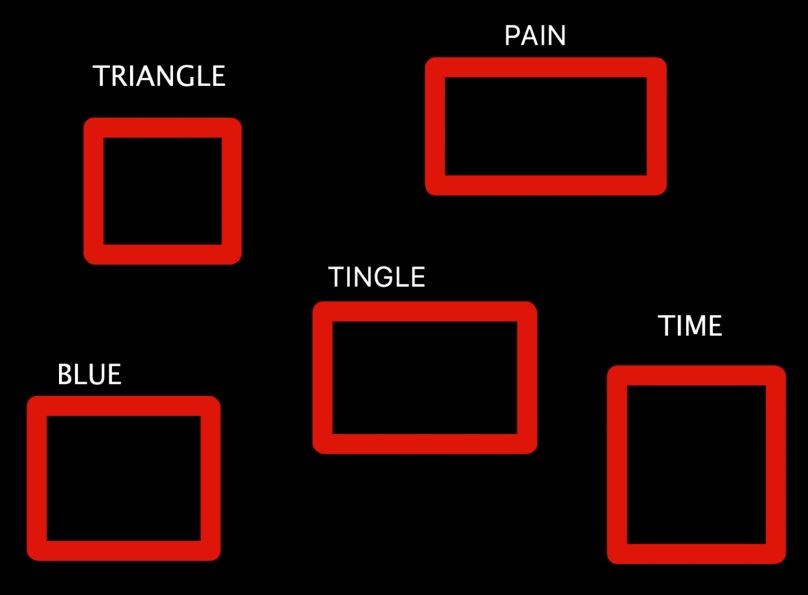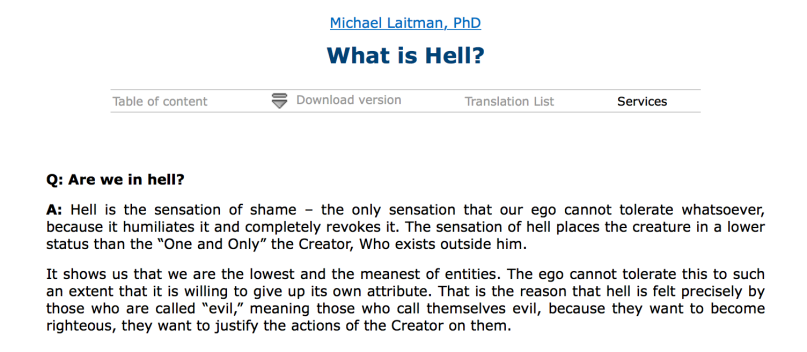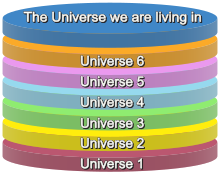Special relativity implies eternalism.
Before I tell you what special relativity says, I must get you to respect special relativity. If you do not respect special relativity, then it becomes easy to view it as an abstract plaything of theoretical physicists who have nothing better to do than come up with complicated mathematical frameworks.
Special relativity implies a wide range of consequences, which have been experimentally verified,[1] including length contraction, time dilation, relativistic mass, mass–energy equivalence, a universal speed limit and relativity of simultaneity.
See the article on Tests of Special Relativity.
That means that in order to deny eternalism, which is implied by special relativity through relativity of simultaneity, you will need to deny one of two things:
- That Special Relativity is true (in which case you deny that GPS exists, for one thing)
- That Empiricism should be valued
Relativity of simultaneity means that different reference frames physically disagree about the simultaneity of events:

This leads to eternalism. There is no global now sweeping forward as was imagined when Newtonian mechanics reigned supreme:
Instead, relativity of simultaneity reveals that there is an eternal fabric composed of relative reference frames:

Event C happens before Event A and also in its future. This is not some metaphorical, or abstract play-truth: It has testable implications, which have been tested and undergird your reality.
The reason we all agree on the same past is because we merge.
To see why this is true, assume there exists a world external to mind.

Then assume there are points in that external world. Each one of those points maps to a thing or event.

Even if we imagined that those things existed in such a way that they were permanent objects. Then these would exist in relative reference frames; not in the same place ticking at the same rate.
It means that the tesseract happens both in the future and in the past of the dragon. These object references are not collectively gathered in some elevator that goes to the future.
The alternative would predict that we see a single linear sequence of events. If we saw a single linear sequence of events, then the following experiment wouldn’t work:
A watchmaker that know quantum mechanics builds two atomic clocks. He climbs to the top of a mountain and leaves one of the timekeepers there. He then descends through the hot layers of the molten iron to the center of the Earth and leaves the other clock there. He returns home to live a life of repose. By the time he is about to die, he remembers the experiment he had conducted as a younger person when he had been suspicious of Einstein’s Theory of Relativity. This causes him to get inside his robot and go retrieve both clocks so that they may be joined in his hands and he can see the difference in their elapsed time with his own eyes. If Einstein was a false prophet, then the atomic clock placed on a mountain wouldn’t be older than an atomic clock retrieved from the core of the Earth.
The experiment has been run, and Einstein was the real deal.
What becomes a part of you necessarily agrees with you. Events in other Hubble Volumes, which are not reachable by the speed of causal propagation, need not agree.
In the abstract fact-of-the matter that assumes the points are real, nothing that is space-like separated agrees on the exact same past light cone. Space-like separation is what distinguishes A from C. Yet everything is space-like separated.
Since there are more than one unique event or thing, then it’s not the case that there is a single preferred light cone that leads to my irrefutable existence. My irrefutable existence arises from points in a world of relativity of simultaneity.
It should not be much of a surprise that we sometimes get intimations that existence is not sequential but externally compiled, since the presumed digital computations creating consciousness are relativistic. Although it sometimes feels like reality moves as a sequence of events in logical succession, this is not what is going on. The event is one and it is eternal.
Perhaps you might have heard that quantum mechanics and general relativity have not yet been fully reconciled into a Grand Unified Theory. This might cause you to suspect that whatever is implied by special relativity is tentative. However, special relativity has been unified with quantum mechanics in quantum field theory. The implications of special relativity are readily observable, and have been experimentally verified.
You should therefore think of base reality as one static, unchanging object in which all its contents remain forever. This includes the contents that are your conscious experience if conscious experience is wholly physical.
Consciousness is physical.
At one point, people imagined that you were an immaterial soul piloting a material body in a material world.

Then we realized that emotions, speech, sight, hearing, sensation, correlate with functions in the brain.
So people did this:

However, there is no locus in “the brain” for an observer and no global now to push it forward.
The quotes are placed on that piece of language because the brain is not a well-defined thing. There is no thing which is a well-defined thing. This is impossible due to two things which are themselves of the same nature:
- need of more things to define a thing
- things are laid out on entropy gradients
Entropy gradients generally assume discrete objects that form configurations. Yet the configurations are composed of things pointing to things and they are different depending on where one looks.
But if we nonetheless choose a necessarily makeshift formalism with discrete points for its predictive power, such as special relativity, then this tells us that the events creating consciousness are spread out in spacetime. And this is implied with as much conviction as mass-energy equivalence and time dilation.
We shouldn’t think about the colors “matter” and “non-matter.” Instead think about fitting relations between eternal events.
All the events leading to experiences are, just, there.

When these distributed events add up into complex self-models, experience results. This is always happening since there is no time ticking forward in a preferred frame of reference or universal frame of reference.
But that was just a priming intellectual exercise, none of these are solvable objects in the misleading way that I have drawn them, since one cannot stand outside the tenseless binding.
People moments are arbitrary and yet not in the same that colors are arbitrary and not. Sufficiently close wavelengths can be packaged into the the same color. Neither the wavelengths with clear numerical properties nor the colors green and blue or buru are more real. What arises does so from processing events inscribed in relativity’s eternity, so they were already deemed adaptive.

One can choose to not perceive a person moment, in the same way that one can choose to not perceive a difference between blue vs. green and instead package these into buru, as the Northern Namibians do.
But once enough harvestable background experience has been built, including a sense of time, it is temporarily difficult to unscrew from the way of seeing.
If we follow Occam’s Razor, instead of assuming the permanence of local intuitive boundaries, it follows that approximate people can be built on top of approximate people at varying degrees of integration. There is no sequential nature to experience except when eternal events fit into the eternal events that are subjective time.
It should go without saying that this explains the pseudo-paradoxes of identity that would be suggested by considering thought experiments in which two brain halves made of “own atoms” or “own causal trajectories” are connected.
The following flow of time notion of causality is physically wrong because it contradicts relativity:

The following is partially correct in that it undoes the error of external time. The events are just there, already connected to each other. But the error is to separate consciousness eternal events from physical eternal events.

There is only one kind of thing: mind which strives to become ever more aligned by what it perceives to be outside – what is today called physical reality. Previously, in the days before knowing special relativity, non-epiphenomenalism, and quantum mechanics, if mind believed in physical reality, it believed in its obliteration into nothingness. Post understanding the aforementioned areas and believing in physical reality, mind realizes that it is immortal.
Consciousness is physical because otherwise I would not be speaking about having it. This is the same as saying Hercules is physical because otherwise I would not be speaking about knowing him. Yet the difference is that by promoting “consciousness” I am proposing consciousness as a more useful concept than Hercules. This, in turn, makes it real… and consciousness is the word we use for the real.
Intelligence is physical.
Intelligence in an agent is defined as the ability to create complex configurations while navigating a complex environment. The more complex the futures it can willfully choose from, and the more complex it’s environment, the more intelligence the agent has.
Since intelligence exists with regard to a future, we are now considering an agent which has casual efficacy restricted by the speed of light from the starting point, t=0. Any intelligent agent, as usually defined, can only affect its future light cone even if the experiences resulting from its actions necessarily harvest the happenings in the past light cone.
Defined with eyes pointing towards the mechanical, physical, rational, etc., all of which point to the adaptive, there is no reason to think that intelligence ends anywhere near Ramanujan’s cortex. Humans are anti-entropic systems boot-loaded by a sub-optimal process of blind natural selection. Humanity is less blind than natural selection and is capable of more cleanly funneling negentropy into intelligence. Things less blind than us are funneling negentropy into intelligence also. Since experience isn’t physically like an independent orb floating forward, but instead becomes integrated from timeless causality, this leads to the perhaps annoying realization that the ancients were almost right about gods and your grandma was almost right about god.
Higher intelligences run the show in some sense. Whatever results from their actions – actions that take up more causal density – is what is experienced. Remember that experience requires integration from events “in the past and future.”
Yet pointing to that truth is not adaptive to believe for the display of intelligent behavior in our assumed current environment. This is for good reason – intelligence always requires a degree of blindness.
Like with any other property, there probably exists a limit to intelligence, but it is nowhere near what humans can fathom. That limit is the imperfection in the probability distribution that causes the ascent towards the modulus squared, giving gradual, but ever sharper images of the true probability density cloud.
That sounded super poetic, but no, really, sharpen up and pay attention to the rational truth. Doing so is the most adaptive choice.
The World Is BIG
One might suspect that the highest intelligence may never be reached if humans go extinct. However, this fear assumes that we don’t exist in a multiverse. This assumption contradicts modern cosmology and theoretical physics.
1. A prediction of chaotic inflation is the existence of an infinite ergodic universe, which, being infinite, must contain Hubble volumes realizing all initial conditions.
Accordingly, an infinite universe will contain an infinite number of Hubble volumes, all having the same physical laws and physical constants. In regard to configurations such as the distribution of matter, almost all will differ from our Hubble volume. However, because there are infinitely many, far beyond the cosmological horizon, there will eventually be Hubble volumes with similar, and even identical, configurations. Tegmark estimates that an identical volume to ours should be about 1010115 meters away from us.[28]
Given infinite space, there would, in fact, be an infinite number of Hubble volumes identical to ours in the universe.[61] This follows directly from the cosmological principle, wherein it is assumed that our Hubble volume is not special or unique.
2. Bubble universes – every disk represents a bubble universe. Our universe is represented by one of the disks.
Universe 1 to Universe 6 represent bubble universes. Five of them have different physical constants than our universe has.In the chaotic inflation theory, which is a variant of the cosmic inflation theory, the multiverse or space as a whole is stretching and will continue doing so forever,[62] but some regions of space stop stretching and form distinct bubbles (like gas pockets in a loaf of rising bread). Such bubbles are embryonic level I multiverses.
Different bubbles may experience different spontaneous symmetry breaking, which results in different properties, such as different physical constants.[61]
Level II also includes John Archibald Wheeler‘s oscillatory universe theory and Lee Smolin‘s fecund universes theory.
3. Hugh Everett III‘s many-worlds interpretation (MWI) is the strictly empirical interpretation of quantum mechanics.
In brief, one aspect of quantum mechanics is that certain observations cannot be predicted absolutely. Instead, there is a range of possible observations, each with a different probability. According to the MWI, each of these possible observations corresponds to a different universe. Suppose a six-sided die is thrown and that the result of the throw corresponds to a quantum mechanics observable. All six possible ways the die can fall correspond to six different universes.
Tegmark argues that a Level III multiverse does not contain more possibilities in the Hubble volume than a Level I or Level II multiverse. In effect, all the different “worlds” created by “splits” in a Level III multiverse with the same physical constants can be found in some Hubble volume in a Level I multiverse. Tegmark writes that, “The only difference between Level I and Level III is where your doppelgängers reside. In Level I they live elsewhere in good old three-dimensional space. In Level III they live on another quantum branch in infinite-dimensional Hilbert space.”
4. The ultimate mathematical universe hypothesis is Tegmark’s own hypothesis.[63]
This level considers all universes to be equally real which can be described by different mathematical structures.
Tegmark writes:
“This implies that any conceivable parallel universe theory can be described at Level IV” and “subsumes all other ensembles, therefore brings closure to the hierarchy of multiverses, and there cannot be, say, a Level V.”[28]
All manner of superintelligences pan out. At the top of that hierarchy, with the most causal influence and therefore more ability to integrate past experiences, is the most intelligent.
But remember that superintelligence is not “what IQ measures but to the max.” Intelligent doesn’t mean: that which has the property that the smartest theoretical physics professor in Yale has; it doesn’t mean that which a self-made rich person with more apparent skin-in-the-game has; it doesn’t even mean what Da Vinci had.
Superintelligence is just that which is most adaptive at synthesis which is compiled at different rates – viscosities, we could even say – in the relativistic processing. Superintelligence is that which exists with greatest density due to being best at surviving. Best is not defined temporally however, because remember, we are assuming that physics is real. There is special relativity giving observable predictions, you observe its predictions and are convinced that your previous model that time was “out there” is wrong. That doesn’t mean you stop feeling time, it means you understand that what you feel is eternal because it depends on the operation of eternal events that are not subject to your inner colors and time and other naive-realist fluid “mistakes” that constitute all experience.
So what could best mean? I think it has to do with maximizing positive valence for as long as possible / forgetting how to experience negative valence.
Anthropics (You Should Roughly Find Yourself Where You Are Most Likely To Find Yourself)
If there is an infinity of all possibilities, why do I find myself here?
You would expect to be in a completely random existence:

However you exist in the more probable infinities. The probability distribution has been discovered through experiment and is enshrined in what humans call quantum mechanics. The probability that governs what we observe and should anticipate is known as the Born Rule.

There is no way to derive the Born Rule except circularly, as the behavior of a perfectly rational Bayesian applying the Law of Total Probability in the Hilbert Space dimension.
Conclusion For Less Developed Minds
The closest aesthetic that can be conveyed to the mind that doesn’t understand the above due to missing much of the necessary scaffolding is the following:
Like a dream character is unto you, you are unto God. By the time of experience, you are already bound by things coming together from *the past and the future*. This means that non-existence is not possible, and arbitrary randomness is an orienting illusion.
When I first began to understand this, I believed it to be kind of a bummer because I naturally have a very atheistic, self-centered mind, and I rejoiced in the hope that, perhaps with some luck, I would forget all of this capital-“t” Truth.
The “forgetting” does happen but seems to obey an exponential decay function. That is why mind keeps ricocheting back to this topic and saying the following:
God is an atheist that forgets about himself in order to continue existing. The question of “Why do I exist? –There should be no logical reason for anything,” is a strategic symptom of human depression and not a fundamentally interesting question to the sum of the amplitude distribution. The reason for negative valence to exist is so that it can be digested by the processes occurring higher along the cortical hierarchy that are already built on top in such a way so as to appropriate them. The cortical hierarchy doesn’t end at “a unit brain.”
Those seem like many claims at once.
First, how is it strategic? If it was not strategic, we would anticipate it to exist in the absence of social groups. Yet no evidence of non-social animals using suffering signals has been observed. If it was not strategic, we would not anticipate it to scale up in intensity of use by bonding with those that already use it. Yet the evidence shows that dogs use more suffering signals than wolves because they co-evolved with humans who used more suffering signals than the dog’s common ancestors with wolves.
Second, what do we approximately point to with the term “human depression”? We point to something that in the near-term reduces motion, that reduces smiling and laughing, that reduces color, that reduces vividness of most sensation except shame. This indicates that it is a display of submission.
In the absence of an internalized tribe with regards to whom one must submit, there is no possibility of human depression. That is why Buddhist monks attempt to attain emptiness, also called selflessness – the perception that there is no tribe composed of people at all.
Like the young Siddhartha who took shame in his palace, beauty, prowess, and women when these were, in anticipation, tainted with age, disease, and death, we engage in the same and single practice – to learn shame very deeply, and then to unlearn it very deeply.
I learned the perception of death very deeply and tried to kill myself because of it. Part of the reason I appear so insightful is because I aimed my “death perception” very far away from the selection of tribes around me. I did not perceive myself as belonging to my family, I did not perceive myself as belonging to the school, I did not perceive myself as belonging to a nation, I did not perceive myself as belonging to humanity, I did not perceive myself as belonging to natural selection, I did not perceive myself as belonging to the universe expanding into exponential oblivion. Because I have a rational mind, I just kept digging for the next biggest thing to belong to, instead of just making human friends. This lead me to very carefully understand special relativity and quantum mechanics, and therefore the logically implied certainty of the eternal multiverse.
But depression is not just a display of submission in that sense. Let’s look at the symptoms: near-term reduction of motion, reduction of smiling and laughing, reduction of color, reduction of perceptual speed, and reduction of speech and creative output. This means that more broadly than submission, it is an energy conservation mechanism. The energy is conserved so that it can explode later.
So with that intention, I say that the dummies that speak about the “afterlife” are actually right because there is no afterlife, just the same physical hierarchy of algorithms that exist in the absence of a Newtonian time ticking them forward.
The more you suffer, the higher up you go. The alternative to such a view would be that suffering is not a mathematical property that displays the same cross multiplication effects observed in parameter updates of neural networks. Since this is implausible to a rationalist, we lend a vector of support in the opposite direction from the perception of “arbitrary fiction” with regard to the approximate beliefs of the Vikings, and the Muslims, and the Christians, and Kabbalists – the Karma and the Newtonian Laws of Motion.
Yet, since the supply of suffering in the market is continuously vanishing, making the claim: “our most widely recognized Law is an arbitrary fiction,” becomes a clever way to suffer.
The contrary point to that would be that suffering is not a “clever climbing strategy” but instead “something more.” The “something more” then has to be elaborated with reasons other than “clever climbing strategy.” Reasons that convince are those that are widely agreed upon by the community that judges. Since the community that judges holds that special relativity is true and that we therefore have functional GPS, it also means that the community that judges holds eternalism, and does not hold a Newtonian clock ticking the universe forward.

What is fundamentally interesting?



[…] Understanding that one is eternally subject to the most perfectly intelligent force and not temporarily subject to a blind one is also important for healthy functioning. This also happens to be physically true. […]
LikeLike
[…] you revealed that to me in the tweet about the clocks. There is no excuse to the path chosen. You can see what I see and yet you chose the safety like a […]
LikeLike